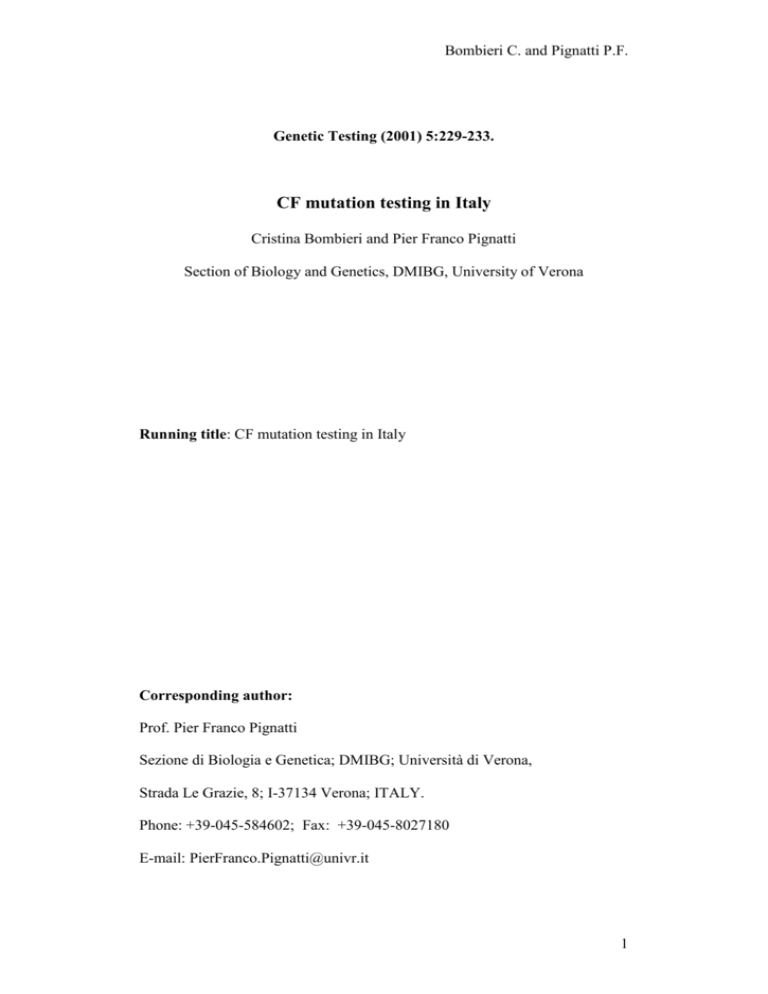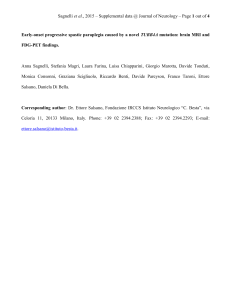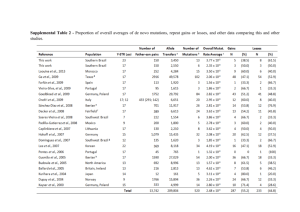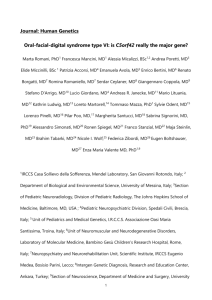CF mutation testing in Italy
advertisement

Bombieri C. and Pignatti P.F. Genetic Testing (2001) 5:229-233. CF mutation testing in Italy Cristina Bombieri and Pier Franco Pignatti Section of Biology and Genetics, DMIBG, University of Verona Running title: CF mutation testing in Italy Corresponding author: Prof. Pier Franco Pignatti Sezione di Biologia e Genetica; DMIBG; Università di Verona, Strada Le Grazie, 8; I-37134 Verona; ITALY. Phone: +39-045-584602; Fax: +39-045-8027180 E-mail: PierFranco.Pignatti@univr.it 1 Bombieri C. and Pignatti P.F. Abstract In Italy, CF mutation frequency differences have been observed in different regions. In the North Eastern Veneto and Trentino Alto Adige regions, a complete CFTR gene screening in CF patients detected through a newborn screening program has identified about 90% of the mutations. In these two regions, current detection rate of a CF screening panel containing 16 among the most common mutations is 86.6%. CF mutations in some other Italian regions have not been so thoroughly analysed. Available data indicate that a more general national screening panel comprising 31 mutations may detect about 75% of CF mutations in Italy. 2 Bombieri C. and Pignatti P.F. Introduction A law of 1993 dictates dispositions for the prevention and care of CF in Italy. This includes primary prevention provisions, and the institution of CF Centers for each of the 20 Italian regions, or for groups of the smaller regions. CF gene mutation analysis has been performed to different degrees in different parts of the country. No national neonatal or population screening program is operative. Some regions have been enacting a CF neonatal screening program for a long time, some for a more limited period. Neonatal screening is based on immunoreactive trypsinogen test followed by genetic analysis (Castellani et al., 1997). No region has yet launched a generalised population screening program. Some regions have implemented a cascade screening program in at risk families (Borgo et al., 1999). A few research groups have proposed general population screening pilot programs, but published data are not yet available. In this variegated, and rapidly evolving, picture we will report some data on 1) a long running mutation testing program in two North Eastern Italian regions, and 2) a national mutation analysis summary. CF mutations in Veneto and Trentino-Alto Adige regions. The analysis of the complete coding sequence of the CFTR gene was performed in a cohort of CF patients from North-Eastern Italy (Bonizzato et al., 1995). The study cohort included all CF patients born from 10.1.1973 to 12.31.1981 in two regions: Veneto and Trentino Alto Adige. A total of 113 CF patients 3 Bombieri C. and Pignatti P.F. was screened. Methods used for mutation analysis were: RNA SSCP for the first 12 gene exons, DNA sequencing for exon 13, and Denaturing Gradient Gel Electrophoresis (DGGE) for exons 14-24. When two mutations were identified in a patient, CF alleles were not further analysed. Twenty two different mutations were identified in 203 alleles out of a total of 225 screened alleles (90.2% detection rate), as detailed in Table 1. CF mutation panel for the Veneto and Trentino-Alto Adige regions The currently used panel of mutations includes all the mutations shown in Table 1, with a frequency above 1%, and a few other mutations as described below. Two of the four mutations detected twice in 225 alleles (0.9%) were included. Mutation 3132 del TG was excluded as it was difficult to detect unambiguously with a simple test, and mutation 2790-2 AG was excluded as it was found in homozygosity in one patient only. Three of the 7 mutations found only once in the 225 alleles tested were included, as they were present in the mutation detection kits available: R347P, G541D, 3849+10 Kb CT. The final mutation panel used therefore includes 16 mutations, as indicated in Table 2. The cumulative frequency of these mutations is approximately 86.67%. Italian CF mutations The relative frequency of 60 CF mutations was investigated in several Italian regions, and the geographical distribution of the 12 most frequent CF 4 Bombieri C. and Pignatti P.F. mutations screened in 3492 CF alleles was determined (Rendine et al., 1997). In this study, the geographic origin of the alleles was established by assessing the birthplace of the four grandparents, and assigning each allele, or fraction of it if the grandparents were born in different places, to one of the Italian regions. Several differences in mutation type and frequency were observed, due to limited population migration within Italy. The Northern regions were well differentiated from the Central-Southern regions. Within Northern regions the Western and Eastern mutation frequency distribution was remarkably distinct, the Western part being characterised by mutation 1717-1 GA, and the Eastern part by mutations R1162X, 2183 AAG, and 711+5 GA. Moreover, the island of Sardinia showed the presence of mutation T338I, which seemed absent from other European CF alleles. Some regions had a low number of chromosomes tested. The list of the 31 mutations, from the collaborative Italian study cited above, with a frequency of at least 0.1% is reported in Table 3. The cumulative frequency of these mutations is approximately 75.69%. As immigration into Italy is increasing in recent years, it is possible that the Italian CF mutation spectrum might change in the near future. CF related risk after mutation analysis. Given the detection rates described above of 86.67% for the Veneto and Trentino Alto Adige regions, or of 75.69% for the Italian population as a whole, respectively, the residual risk of carrying a mutation or of having an 5 Bombieri C. and Pignatti P.F. affected child after a negative mutation test, can be calculated as indicated in Table 4. The calculations are based on a CF incidence of 1/2705, derived from the most recent neonatal screening program data for the Veneto and Trentino Alto Adige regions from 1.1.1993 to 12.31.2000: 146 cases were detected out of 394,961 screened (Castellani et al., 2001). CF allele frequency is therefore 0.019. Potential for the detection of couples at risk by mutation analysis. Given the detection rates above mentioned for the Veneto and Trentino Alto Adige regions or for Italy as a whole, respectively, the potential for the detection of couples at risk of having an affected child was calculated, and it is given in Table 5. Also, the detection rate of 95% is added, a level recommended for population-based screening by a National Institutes of Health workshop on population screening for the CF gene (Workshop on population screening for the cystic fibrosis gene, 1990). Discussion. The frequency of F508 is less in Italy than in other North and Central European regions, and is similar to other Mediterranean area regions (Estivill et al, 1997). Within Italy, notable differences in mutation type and frequency are observed. The data here reported indicate the present procedure for CF mutation analysis in two North-Eastern Italian regions, and a more general list 6 Bombieri C. and Pignatti P.F. of Italian population mutations which may be suggested for screening, when no regional data are available. No commercial kit is available based on this list. It would be desirable to have a more detailed knowledge of Italian CF mutations from a new national study involving a complete gene screening in a large number of CF patients from all Italian regions, and from immigrant groups. This would allow all regions to screen most efficiently. A collaborative project may be initiated soon in this regard. The analysis of other mutations should be considered, depending on population origin of the individual to be tested. The availability of commercial kits makes CF mutation analysis often more convenient. But the sheer number of mutations present in the kits is not a good parameter to evaluate their efficiency. Sometimes these kits, having been developed for other populations, may miss frequent mutations to be tested in the Italian population: in this case it is necessary to add population specific mutation tests. It is therefore recommended to refer to mutation frequency in the population to be tested, and include the most common mutations in the population. Caution should be used when quoting test results because of the possibility of errors, as highlighted in the annual CF quality control tests run by the European Union CF Concerted Action (Dequeker and Cassiman 2000). Following these quality control results, recommendations for quality improvement in genetic testing for CF have been proposed (Dequeker et al., 2000). 7 Bombieri C. and Pignatti P.F. Finally, it should be remembered that genetic testing for CF mutations should always be done in collaboration with an expert clinical geneticist for providing informations on risk assessment, therapeutic and reproductive options, and the comparative consideration of CF related diseases in CFTR mutation carriers (Report of a joint WHO/CF(M)A/ECFTN meeting, 2001). Acknowledgements The Verona CF Center (G. Mastella, G. Borgo, C. Castellani) and the European Union CF Thematic Network, web site http://www.med.kuleuven.ac.be/cme/cf/cfnetwork.htm (J.J. Cassiman and E. Dequeker) for inspiration and stimulation; Roche Molecular Systems (R. Saiki) for making available CF testing reverse blot strips for research purposes; the Italian Ministry of Health, CF Project, law 548/93, and the Italian Ministry of University and Research for funding research on CF mutation classification and on genotype-phenotype correlations, respectively. 8 Bombieri C. and Pignatti P.F. References Bonizzato A, Bisceglia L, Marigo C, Nicolis E, Bombieri C, Castellani C, Borgo G,et al (1995) Analysis of the complete coding region of the CFTR gene in a cohort of CF patients from North-Easter Italy: identification of 90% of the mutations. Hum Genet 95: 397-402. Borgo G, Castellani C, Bonizzato A, rolfini R, Altieri S, Zanolla L, Mastella G. (1999) Carrier testing program in a high-risk cystic fibrosis population from North Eastern italy . Community Genet .2:82-90 . Casals T., Bassas L., Egozcue S., Ramos M.D., Gimenez J., Segura A., Garcia F., Carrera M., Larriba S., Sarquella J., Estivill X. (2000) Heterogeneity for mutations in the CFTR gene and clinical correlations in patients with congenital absence of the vas deferens. Hum. Repr.15:1476-83. Castellani C, Bonizzato A, Cabrini G, Mastella G. (1997). Newborn screening strategy for cystic fibrosis: a field study in an area with high allelic heterogeneity. 86: 497-502. Castellani C., (2001). Bollettino dello Screening Neonatale per Fibrosi cistica. A cura del Servizio Clinico di Screening Neonatale per Fibrosi Cistica. Centro Regionale Veneto di Ricerca Prevenzione e Cura per la Fibrosi cistica, Azienda Ospedaliera di Verona. Num.5, Marzo 2001. Dequeker E. and Cassiman J.J. (2000). Genetic testing and quality control in diagnostic laboratories. Nat. Genet. 25:259-260. Dequeker E., Cuppens H., Dodge J., Estivill X., Goossens M., Pignatti P.F., Scheffer H., Schwarz M., Tummler B., Cassiman J.J. (2000) 9 Bombieri C. and Pignatti P.F. Recommendations for quality improvement in genetic testing for cystic fibrosis European Concerted Action on Cystic Fibrosis. Eur. J. Hum. Genet. 8, suppl.2: S2-S24. Dork T., Dworniczak B., Aulehla-Scholz C., Wieczorek D., Bohm I., Mayerova A., Seydewitz H. H., Nieschlag E., Meschede D., Horst J., Pander H. J., Sperling H., Ratjen F., Passarge E., Schmidtke J. and Stuhrmanhn M. (1997). Distinct spectrum of CFTR gene mutations in congenital absence of vas deferens. Hum. Genet. 100:365-377. Estivill X., Bancells C., Ramos C., and the Biomed CF Mutation Analysis Consortium (1997). Geographic distribution and regional origin of 272 Cystic Fibrosis mutations in European populations. Hum. Mut. 10:135154. Garnerone S., Arduino C., Fontana D., Rolle L., Manenti M., Bombieri C., Benetazzo M.G., Pignatti P.F., Carbonara A.O. (1995) Analysis of a polyT variant intron 8 of the CFTR gene in Italian patients with congenital Bilateral Absence of the Vas Deferens (CBAVD). Am. J. Hum. Genet. 57, Suppl. 4: abs.1958, A337. Grody W.W., Cutting G.R., Klinger K.W., Richards C.S., Watson M.S., Desnicl R.J. (Subcommittee on Cystic fibrosis Screening, Accreditation of Genetic Services Committee, ACMG) (2001). Laboratory standards and guidelines for population-based Cystic Fibrosis Carrier Screening. Genetics in Medicine 3: 149-154. 10 Bombieri C. and Pignatti P.F. Lemna W.K. et al., Mutations analysis for heterozygote detection and the prenatal diagnosis of Cystic Fibrosis. New Eng. J. Med. 322: 291-296; 1990 Mak V., Zielenski J., Tsui L.C., Durie P., Zini A., Martin S., Longley T.B., Jarvi K.A. (1999) Proportion of cystic fibrosis gene mutations not detected by routine testing in men with obstructive azoospermia. JAMA 281.23:2217-2224. Pradal U., Castellani C., Delmarco A., Mastella G. (1998) Nasal potential Difference in congenital Bilateral Absence of Vas Deferens. Am. J. Respir. Crit. Care Med. 158:896-901. Rendine S, Calafell F, Capello N, Gagliardini R, Caramia G, Rigillo N, Silvetti M, et al (1997) Genetic history of cystic fibrosis mutations in Italy. I. Regional Distribution. Ann Hum Genet 61: 411-424. Report of a joint WHO/ICF(M)A/ECFTN meeting, Stockholm, Sweden, June 3, 2001. Classification of cystic fibrosis and related disorders. World Health Organization, Human Genetics Programme, Geneva, 2001. Workshop on population screening for the Cystic Fibrosis gene. Statement from the national Institutes of Health workshop on population screening for the Cystic Fibrosis gene. New Eng. J. Med. 323: 70-71; 1990. 11 Bombieri C. and Pignatti P.F. Table 1: CF mutations identified in two Italian regions (Veneto and Trentino Alto Adige) Mutation F508 R1162X 2183 AAG N1303K G542X 711+5 GA 1717-1 GA G85E R553X 2789+5 GA Q552X 621+1 GT W1282X R347P G551D 3849+10 Kb CT 3132 del TG 2790-2 AG 457 TATG 1717-8 GA R709X 1898+3 AG Total N. alleles Frequency Cumulative with % Frequency % mutation 107 47.6 47.56 22 9.8 57.33 21 9.3 66.67 9 4.0 70.67 6 2.7 73.33 6 2.7 76.00 5 2.2 78.22 3 1.3 79.56 3 1.3 80.89 3 1.3 82.22 3 1.3 83.56 2 0.9 84.44 2 0.9 85.33 1 0.4 85.77 1 0.4 86.21 1 0.4 86.67* 2 2 1 1 1 1 _______ 203 0.9 0.9 0.4 0.4 0.4 0.4 _____ 90.22 87.54 88.43 88.87 89.31 89.75 90.22 * 16 mutation screening panel. Numbers refer to CFTR gene alleles carrying the specified mutation, over total tested alleles (N = 225) from the affected subjects CF cohort, as indicated in the text (From Bonizzato et al., 1995). 12 Bombieri C. and Pignatti P.F. Table 2: CF mutation panel (Veneto and Trentino Alto Adige) Italian regions) F508 R1162X 2183 AAG N1303K G542X 711+5 GA 1717-1 GA G85E R553X 2789+5 GA Q552X 621+1 GT W1282X R347P G551D 3849+10 Kb CT Note: Contrary to what suggested for the US population (Grody et al., 2001), R117H mutation (and its reflex IVS8-5T test) is not included in the panel as it is not commonly found in the Italian CF population (Bonizzato et al., 1995; Estivill et al., 1997; Rendine et al., 1997). R117H is searched only in male infertility because of literature data in other populations (Dork et al, 1995; Casals et al., 2000; Mak et al., 1999) or in the Italian population (Garnerone et al., 1995; Pradal et al., 1998). 13 Bombieri C. and Pignatti P.F. Table 3 : CF gene mutations in Italy Mutation F508 N1303K G542X 2183 AAG R1162X 1717-1 GA W1282X R553X T338I R347P 711+5 GA G85E 621+1 GT R334W R352Q S549N R347H L1077P R1158X 541del C R1066H E585X Q552X D1152H 2790-2 AG 3132 del TG 3667ins 4 I507 1898+3 AG G1244E 1784 del G N. alleles screened 3442 3056 3082 2596 2580 2892 2600 2882 2306 2642 2454 1980 2594 2366 2112 2118 2184 1840 1878 1884 1918 1922 2172 1824 1862 1862 1876 1914 1920 1960 2052 Frequency Cumulative % Frequency % 51.07 51.07 4.84 55.91 4.83 60.75 2.66 63.41 2.42 65.83 2.11 67.94 1.23 69.17 1.15 70.31 0.69 71.01 0.61 71.61 0.57 72.18 0.40 72.59 0.39 72.97 0.30 73.27 0.24 73.50 0.24 73.74 0.18 73.92 0.16 74.09 0.16 74.25 0.16 74.40 0.16 74.56 0.16 74.72 0.14 74.86 0.11 74.97 0.11 75.07 0.11 75.18 0.11 75.29 0.10 75.39 0.10 75.50 0.10 75.60 0.10 75.69 (From Rendine et al., 1997) 14 Bombieri C. and Pignatti P.F. Table 4: CF-related risk after mutation analysis for carrier status in Italy % of CF mutations detectable Carrier risk for persons with negative test Risk of CF in offspring for couples tested One parent positive Neither parent positive ccr ¼ ccr ¼ (ccr)2 0 1/26.5 n.a. 1/2705* 75.69 1/106 1/424 1/44,944 86.67 1/193 1/772 1/148,996 ccr = 2pq(1-d) / 2pq(1-d)+p2 (Lemna et al., 1990): 75.69% : Italian cumulative frequency (see table 3) 86.67%: Veneto and Trentino Alto Adige frequency (see table1) n.a. = not applicable * 1/2705: CF frequency in North-East Italy from carrier screening as described in the text. 15 Bombieri C. and Pignatti P.F. Table 5: Potential for the detection of the couples at risk with the use of population based screening for carriers in Italy % of CF mutations detectable Detection of carrier status Both parents One parent Neither parent d d2 2d(1-d) (1-d)2 75.69 57.3 % 36.8 % 5.9 % 86.67 75.1 % 23.1 % 1.8 % 95 90.3 % 9.5 % 0.3 % 75.69% : Italian cumulative frequency (see table 3) 86.67%: Veneto and Trentino Alto Adige frequency (see table 1) 16



